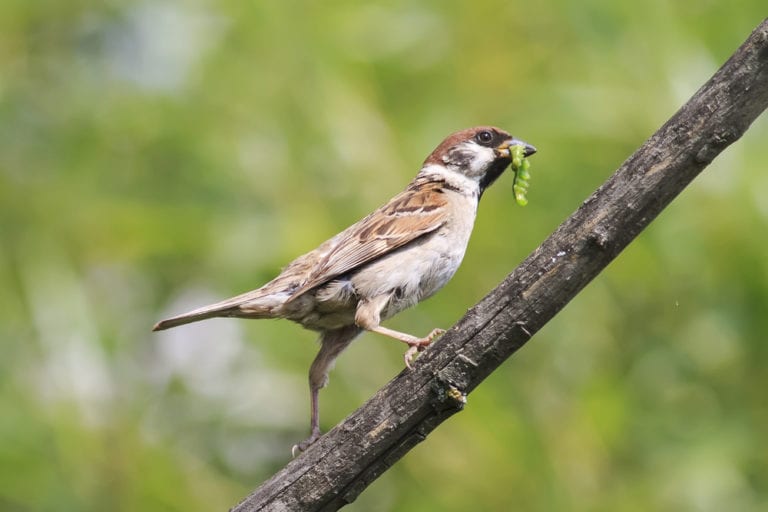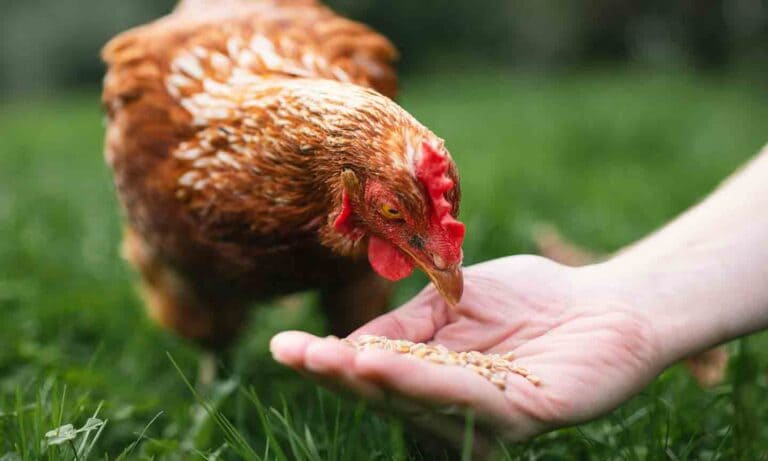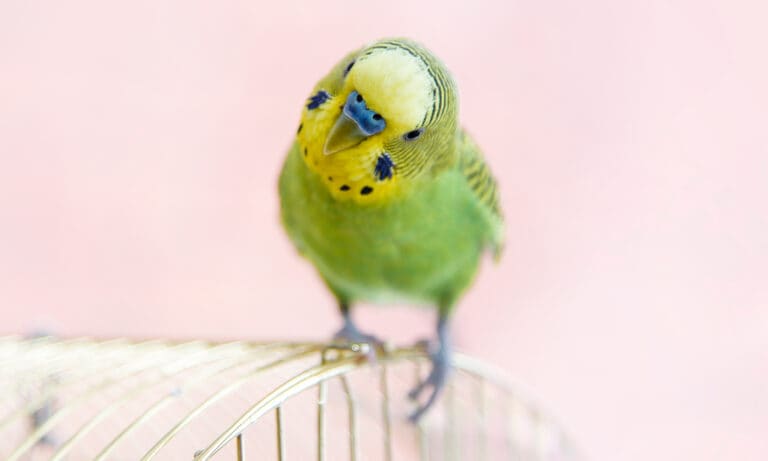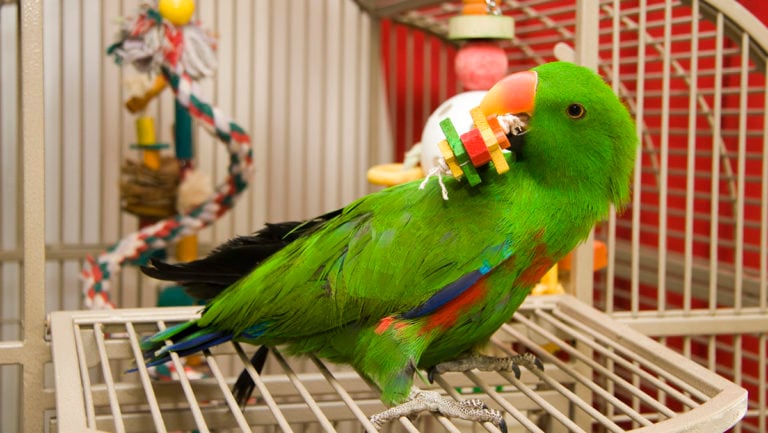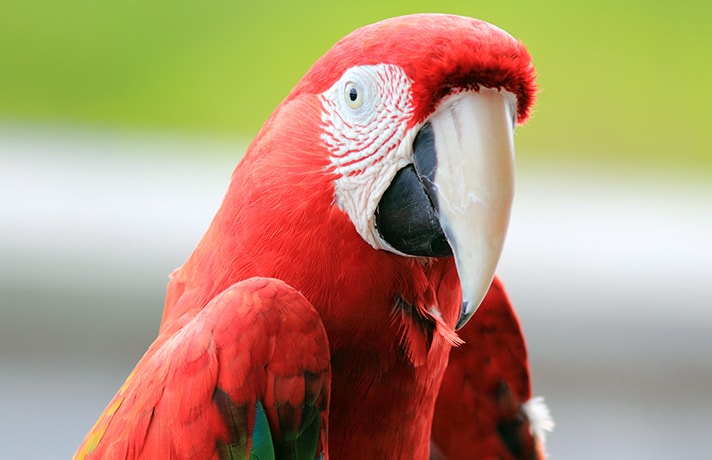There is no hard and fast rule about how often a bird should bathe. Some birds seem to enjoy bathing once a week and look forward to bath-time. Although bathing is an important behavior and valuable for healthy feathers and skin, it is not vital for pet birds, as evidenced by the fact that some pet birds never bathe. I am not condoning not allowing birds to bathe. I do recommend regular bathing. Allow your birds to enjoy a bath from time to time, but don’t stress out if a bird doesn’t want to participate regularly. Bath-time should be a fun enrichment experience and not a negative one.
Why Is Bathing Good For A Pet Bird?
Bathing is a natural, healthy activity for birds. It stimulates preening, which removes dirt, dander and other detritus from the feathers. Birds also seem quite happy and contented after a good bath and preening session.
A bathing bird fluffs her feathers to allow the water to penetrate to the skin. Feathers are somewhat water-resistant, so it may take some time for the water to soak the feathers rather than beading up and rolling. Once wet, the bird runs each feather through her beak, putting the barbs and barbules of each feather in the normal zipped-up position.
A parrot also picks up secretions from the uropygial gland to apply to the feathers. (Not all birds possess an uropygial gland. Amazons and hyacinth macaws lack it.) The secretion contains antimicrobial properties, provides some waterproofing to the feathers and contains vitamin D precursors. When the bird is exposed to ultraviolet light (UVB, in particular), the vitamin D precursors that were spread over the feathers during preening convert to active vitamin D3, which is ingested when the bird preens again. Vitamin D3 is necessary for the proper utilization of calcium.
What If My Pet Bird That Doesn’t Like To Bathe?
Some of these pet birds may not be provided with adequate means to bathe. I have a little trick that works with most birds. Wait until a great thunderstorm arrives, the type where the rain is lashing the windowpanes and you can hear the storm well. Provide the bird with a shallow dish of tepid water, or gently mist the bird with tepid water from a spray bottle. [Beauty supply stores often carry misters that offer a superfine mist setting, ideal for small birds.] The rainstorm cues most birds to begin bathing. For birds that really hate bathing, they may do so only during a rainstorm, or they might lose their fear after a couple of these sessions and begin to enjoy bathtime on sunny days.
If you have a reluctant bather, try lots of different options. Some birds like to bathe in their water dish, some happily bathe in a large, shallow bowl filled with an inch or 2 of water, and others (especially small parakeets) prefer to bathe by rolling in wet grasses or wet greens provided on the bottom of the cage. Splashing under a slow running kitchen faucet is another favorite, and many pet birds like to share bathtime with their owners in the shower.
How Should I Dry My Pet Bird?
Birds will dry off naturally. Once a bird is wet, place it in a warm, dry environment without drafts to finish preening and drying. Some people prefer not to bathe their birds when it is really cold outside, but a warm and steamy bathroom makes a good place for a bird to dry off and preen. The high humidity environment is also very good for the respiratory tract (especially the upper portion consisting of the nares and sinuses) of birds. Amazons, in particular, often have chronic sinus problems during the dry, winter months, and a humid environment often alleviates those problems.
Healthy birds tolerate a wide range of temperatures, which is also true of healthy wet birds. To prevent chilling, I don’t recommend allowing birds to bathe if the ambient temperature is lower than the bird is accustomed to.
What Should A Pet Bird Be Bathed With?
For healthy birds with normal plumage, tap water at a slightly warm-to-the-touch temperature is usually fine, as long as tap water is suitable for consumption by the family and birds. Bottled spring water is a good choice, but I don’t recommend distilled water, which lacks dissolved minerals, salts and ions.
Commercially available sprays and mists designed to clean plumage appear to be innocuous and can be used in the place of water in a spray bottle. Some are not labeled for use on cockatiels and cockatoos, which are dusty birds. Before using any of these products on your birds, always read the label closely, and consult your avian veterinarian to ensure that the product is safe. I do not recommend using mite sprays or other types of sprays that contain medications or insecticides. If you believe that your bird has a medical condition, such as mites, consult with your avian vet for appropriate diagnostics and treatment.
The same goes for birds with feather problems such as broken feathers, chewed feathers, plucked feathers, stress-bars or abnormal feathers; always consult with your avian veterinarian prior to administering home remedies or commercial products. All of these conditions require the expertise of an avian veterinarian.
If a bird’s feathers come in contact with a toxic substance, an avian veterinarian might immerse a bird in water and use a degreasing soap (liquid dish soap) to remove it. It may take months for a bird’s plumage to return to the normal state after bathing with a detergent, so this should be only a last resort for birds that have paint, glue, oil, grease, wax or other substances stuck to the skin or feathers. It is better to spot clean a bird’s feathers rather than clean the entire bird at one time.
You might be able to combine wet greens and a small bowl of water to entice your bird to bathe.
Want to read more about caring for your pet bird? Check out:
By: Margaret A. Wissman, DVM
Featured Image: Via Gina Cioli/Lumina Media
Share:

